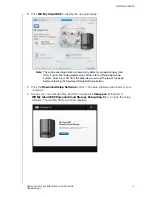
GETTING STARTED
20
WD MY CLOUD EX2 PERSONAL CLOUD STORAGE
USER MANUAL
Once you’ve physically connected your WD My Cloud EX2 device (see “Physically
Connecting the Device” on page 11), use the following steps to access the contents of your
device.
Mapping the Public Folder (Windows)
To map the WD My Cloud EX2 Public folder for quick access in the future:
1. In Windows Explorer, under Network, click
WDMYCLOUDEX2
.
2. Right-click the Public folder and select
Map Network Drive
from the menu.
3. Select the desired letter from the
Drive
drop-down list.
4. Select the
Reconnect at login
check box.
5. Click
Finish
. Your Public drive is now mapped.
If your operating systems is...
Then...
Windows 8 or 8.1
.1
1.
On the Windows 8 Start page, type
Computer
2.
Click
Computer
.
3.
In the left pane, click
Network
.
4.
Double-click
WDMYCloudEX2
and locate the device’s Public
folder.
5.
Double-click the Public folder to display the Shared Music, Shared
Pictures, and Shared Videos subfolders. You can now drag and
drop files into (and from) the shared media folders using Windows
Explorer.
Windows XP/Vista/Windows 7
1.
Click
or
Start
> Computer > Network > WDMYCloudEX2
and, if required, enter your network (router) credentials. The device’s
Public and private folders (shares) display.
2.
Double-click the Public folder to display the Shared Music, Shared
Pictures, and Shared Videos subfolders. You can now drag and
drop files into (and from) the shared media folders using Windows
Explorer.
Mac OS X
(Snow Leopard, Lion, Mountain Lion,
Mavericks)
1.
In a Finder window, click
WDMyCloudEX2
under the shared items
in the side bar.
2.
If presented with an authorization page, select
Guest
, and then
click
Connect
to display the Public share:
3.
Double-click the Public folder to display the subfolders: Shared
Music, Shared Pictures, Shared Videos, and Software. You can now
drag and drop files into the shared folders using Finder:
4.
If you want to create a shared drive icon permanently on your
desktop, create an alias. Following are two ways to do this:
Note:
Before creating an alias, click
Finder > Preferences >
General
and make sure
Connected Servers
is checked.
-
Click the item you wish to alias (e.g., Shared Music), hold down
the mouse button, hold down the
Cmd
and
Option
keys
simultaneously, and drag the item to where you want the alias to
appear. Instead of moving the original item, this creates an alias
at the new location.
-
OR
-
-
Right-click the item you want to alias (e.g., Shared Music), and
then click
File > Make Alias
.






























